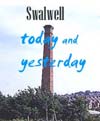
 |
SwalwellMemories |
| Swalwell Cabbage | Swalwell Hoppings | Oliver Cromwell | The Coronation 1953 | Shops by Street | Shops and other memories | Towngate and Keelmen's Bridge |
|
Home Origins Industry Railways Buildings Buildings 2 People Sport Memories Memories 2 Memories 3 Memories 4 Today Links |
MemoriesThis page is devoted to some memories of Swalwell, both old and new, including some reminiscences of Swalwell in the period after the Second World War up to the 1960's. There is also a daily quote from a film, changed regularly, and anything else that I feel like adding.THE SWALWELL CABBAGE
Swalwell has long been famous for the Swalwell Cabbage, grown in 1865. The information given in the link below are from an old account printed by Fletcher's, the Swalwell printers. There is some dispute about exactly where the cabbage was grown. A grandnephew of William Collingwood, Mr Norman Dixon told the local press in the 1970's that it was in a garden behind the farm buildings off Whickham Bank along Scribe Lonnen, but another relation, a Mrs Barras reported from her home in New Zealand that it was nearer Miller's Bridge. The famous gardener did live in a house next to the Buck Inn, now the Poacher, and worked at Ridley's steelworks. It required a handsaw to cut it out and a handcart to carry it to the Buck Inn where it was shown. It was reported that to remove the cabbage from the garden where it was grown the gateposts had to be taken down. William 'Tar' Collingwood ('Tar' from his namesake, Admiral Lord Collingwood - Jack Tar, meaning a sailor), was supposedly a friend of the well-known Tyneside character, Coffee Johnny and was acquainted with Sir Henry Clavering on whose land, given to William Collingwood by Sir Henry, the cabbage may have been grown. True or not, the Claverings did of course own most of the land in and around Swalwell. 'Tar' Collingwood is supposed to have also lived near to the site of Swalwell Club where the steps are at the top of Brewery Bank. William Collingwood was buried in Whickham churchyard following his death on October 8th 1895. Metric equivalents of the Swalwell Cabbage's size and weight are shown below.Height 4 foot 2 inches = 1.27 metres Circumference 7 yards 5 inches = 6.527 metres Weight 123 pounds = 55 kilograms Click here for old printed account. |
Footnote: |
The allotments area known as the 'gardens' was formerly where thousands of tons of cinders and slag from the Crowley works were deposited, and this wasteland was transformed into a cultivated area in which both flowers and vegetables could be grown and was evidently very fertile. Mr Blackbird won the Ramsey Challenge Cup for his leeks four times and was second three times. He also represented Swalwell on the council and was manager of the Co-op for thirty-four years. Mr Archibald Snaith of Richmond Avenue grew a pumpkin weighing 3 stones and four feet seven inches in circumference. Mr Snaith stated that it was fed on washing soda only. Robert Shield (1871 - 1935) who lived in Waterside was another prize-winning local gardener, as was Mr Laybourn who grew giant rhubarb at his Scribe garden. The Scribe also had until about 1950, a large garden with a wooden dwelling house occupied by three sisters who sold apples and pears, soft fruits, flowers and wreaths. |
The Song
Lads! Myek a ring, an' hear hus sing, the sport we had at Swalwell, O, |
Translation:
|
|
This last reference, about many a funny prank being played, is to Crowley's Crew, (see the Swalwell People page), who, together with the local keelmen, were regular visitors to the hoppings. There are eight more verses, mentioning characters like Knack-kneed Mat, Slavering Nell, Gyetside Jack, and Willayton Dan and the song is almost a celebration of Crowley's Crew. In the 1950's the annual hoppings were still going strong with a few fairground rides like the waltzer and merry-go-round, and with coconut and hoop-la stalls, a rifle range and other stalls where you could win various prizes, including a goldfish if you could throw a table tennis ball into one of many goldfish bowls. Tickets were issued to schoolchildren giving half price rides for threepence (1.5p). Popular records of the day were amplified and played all evening. How the residents of Ridley Gardens endured the noise I cannot imagine. N.B. A Fun Fair visited Swalwell in mid-April 2005 but was located on Blaydon Rugby club's premises at Crowtrees Park, the Hopping Field now being occupied by houses. Back to top of page |
THE CORONATION 1953 The Queen's coronation which took place on 2 June 1953 was celebrated by the school, see picture, and there was a street party held in a garage at Long Rigg. Although it rained almost all day there were children's races such as the egg and spoon race and sack race on the path leading to the stepping stones which still existed then. The BBC television transmitter at Pontop Pike had opened in time for the coronation and a few lucky TV owners were able to watch, most of us had to listen on our radios. Schoolchildren were given a souvenir book by Durham County Council, 'The Coronation Book 1953 by William Le Hardy MC., BA., FSA. The history and meaning of the ceremonies at the crowning of HM Queen Elizabeth II'.
The Queen's coronation which took place on 2 June 1953 was celebrated by the school, see picture, and there was a street party held in a garage at Long Rigg. Although it rained almost all day there were children's races such as the egg and spoon race and sack race on the path leading to the stepping stones which still existed then. The BBC television transmitter at Pontop Pike had opened in time for the coronation and a few lucky TV owners were able to watch, most of us had to listen on our radios. Schoolchildren were given a souvenir book by Durham County Council, 'The Coronation Book 1953 by William Le Hardy MC., BA., FSA. The history and meaning of the ceremonies at the crowning of HM Queen Elizabeth II'. Back to top of page |
SHOPS
 People once did almost all their shopping in the village but over the years many shops have closed or have been demolished as shopping habits changed with the advent of the supermarket and widespread car ownership. Many shops and even the buildings which housed them have disappeared over the years. There were once several shops in the Front Street and Station Road area (see picture, right), People once did almost all their shopping in the village but over the years many shops have closed or have been demolished as shopping habits changed with the advent of the supermarket and widespread car ownership. Many shops and even the buildings which housed them have disappeared over the years. There were once several shops in the Front Street and Station Road area (see picture, right),  next to what is now the Angel and near Holy Trinity Church, as well as on the space occupied by the car park next to The Gamekeeper. A detailed history of shops in each street now follows. next to what is now the Angel and near Holy Trinity Church, as well as on the space occupied by the car park next to The Gamekeeper. A detailed history of shops in each street now follows.Axwell TerraceThis street of terraced housing had a shop at the bottom called Barnes Supply Stores, a grocery and general dealer which became Wilson's, and later Charlton's bakery, another general dealer and then a bakery, and was Ramsay's bakery until its recent closure (2005).Clavering RoadA butchers, Billy Brown's and a barbers, and now has a convenience store Nisa A Stores and a take-away, Carlo's fish and chips etc. Parkdale Press were located near the end until making way for the recent housing development. Towards the other end a new shop was built when the street was extended and the Community Centre built, which was also a food store and off licence (Woodley's) and it has changed hands a few times since then. At present it is Henry's News Fruit and Wine store.Crowley RoadAt the corner of Crowley Road were Ramsay's bakery, formerly Colley's bakery (now Swalwell Barbers run by two ladies called Michelle Lawson and Michelle Wilson). Next door was Roper's the cobblers, later Jack's (Knots) greengrocers in the 1970s and now the Sun Studio. Further along the final resting place of the Post Office, which closed in 2005 but is now Swalwell Advice Centre. On the opposite corner was Williamson's greengrocery which was later taken by Olive Hardy and her daughter and later became Gwen's ladies hairdresser and in the 1950s a haberdashers. It is now Lynda's, a ladies hairdressers. To the east was a shop called Atkinson's but known as the school shop and located near the school back gate. There were houses on the land next to Hood Street on the north side of Crowley Road, now grassed over.Foundry LaneFletcher's printers were the main occupants but at one time there was the Co-op abattoir. The old Fletcher buildings were destroyed in a recent fire. Fletcher's once had premises in the old chapel in Station Road next to Bourgognes or the Queens Head as it then was. They are now on the Team Valley trading estate. Next to what was Fletchers in Foundry Lane was Star Plas double glazing (now - 2006 - closed) and Holt's Insulation while Swalwell Motorists have a small garage here, where MoT's can be done.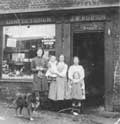
Front StreetThere were several shops here. At Spencer's corner, the building at the bottom of Hood Street was Spencer's haberdashery, then Hawkin's hardware, TJ Robinson's butchers and Armstrong's the barbers. Spencer's shop was formerley occupied by Robson Ryle. These premises are now occupied by Pizza Luciano, and Ladbrokes betting shop.On the next block was Alec McGregor's the drapers (branches in Winlaton Mill and Whickham), the premises later became a funeral director's. The shop became Computer Solutionz and is now Aqualand. Next came the Highlander and the Post Office, later the Angel Guest House, then came Lumley's cafe, a haunt of lorry drivers who parked on the vacant ground off Station Road, once occupied by buildings. Lumleys is now a Chinese take-away, The Double Dragon. Between here and Jubilee Terrace were more buildings, now gone, which housed Topsy Robson's dairy, Robinson's grocery, and Hutchinson's (or Hutcheson's?) original greengrocer's shop. Hutchinson' moved to Napier Road when these properties were condemned. Also trading from here was Jimmy Foster who dealt in firewood from door to door using a horse and cart. At Christmas he would, sell holly, mistletoe and wreaths, also keeping pigs on the allotments known as 'the gardens'. Billy Brown's the butchers had moved next to Robinson's from Spencer's corner where he had occupied Robinson the butchers shop, eventually moving to Clavering Road. Shops also once existed across the road near the Town Gate opposite the Highlander. Hexham RoadThis is that part of the main road through Swalwell which runs to the foot of Whickham Bank and where once the Elephant Inn and Margaret Dabbler's sweet shop stood. Although that part of the block was demolished, the rest is the Jet filling station, with car wash and shop, formerly Fina. Past the former railway bridge is Park Drive with Fred Kain roofing contractor and Blaydon Rugby Club with its large clubhouse and popular Sunday morning car boot sales. On the other side of the road is the mis-named Whickham Nursery and the new Lidl supermarket. The Angel Tea Rooms opened in June 2006 but later closed.Hood StreetHawkins of Spencers' corner on Front Street built premises here which housed a tool hire firm Second Chance, and now occupied by Da Vinci's pizzas and there is a dental mechanics called Dental Repairs.Jubilee TerraceSammy Brewis had a dairy shop here and he later moved to Napier road.Long RiggThe location of Annie Coxon's, the bottom fish and chip shop (see Spencer's Bank) and Wendy's ladies hairdressers which was then a sandwich bar and a tanning studio, the Tanning Booth and Pure Beauty, and then a barbers shop, Joes.Lyndhurst TerraceThis is on Market Lane just down from where the school was andwas the site of Swalwell's original post office which was located in Rutherford's cycle repair shop. Later the co-op took these premises to house the chemists and hardware departments. The post office move back here frorm Front street for a time before going to Crowley Road. The chemists was for a time Swalwell Motorists shop and next door was Peter Pan Upholstery and the Newsmarket at the corner with Napier Road.Market LaneAlthough the Co-op occuped the whole block from Napier Road to Spencer's Bank the next block (now demolished) was occupied by a variety of premises. Arthur Kimber's newsagent's was on the corner next to the Seven Stars and in the same block were at various times Ken Waite's fruit shop, Spoors, a greengrocer's, Ella Wright's ladies hairdressers and Mrs Goodson had a sweet shop there in the 1950's. On the other corner was chemists called Blackbirds with large glass bottles in the shop window. The Cosy cinema occupied the floor above all these premises. Gilmartin's an electrical shop also occupied premises in Market Lane at one time. The Co-op building is occupied by a variety of businesses some of which are around the corner on what was Spencer's bank.Napier RoadFletcher's the printers had a shop here at the top and further down was Nellie Fletcher's, a stationers. In the 1950s there was Gregory's bakery run from one of the houses on the east side near the bottom. They also sold boiled ham, broth and pease pudding. At one time Down the bank on the right were Harry Hutchinson's greengrocer's, next to Hunters, then Morris's a general dealer often called Edna's after Edna Bell who worked there. These premises are now a general dealer Husseins grocery and BUP Auto Parts.On the other side of the road was Lily Angus, (later Vevers and then a newsagent's), then George Shields, a cobblers which later became Ann's family and ladies wear with Craig Veitch, hardware and timber, now Swalwell Taxis. Bowerbank, a dentist, once had a surgery here too. Park TerraceRalph Atkinson's, popularly known as Ralfies shop was in the upstairs part of a house at the bottom of this street and sold a vast number of necessary itms ranging from soap to cigarettes, sweets to sugar and candles, razor blades, pop, by the glass if you preferred, and a million other things. Ralfies was the place to go if you ran out of anything and there was often a queue on the concrete steps leading up to the shop.Quality RowSports Car Supplies have a place here supplying parts for Triumph.Railway StreetThese buildings have had mixed fortunes. On the south side they have all sufferd demolition and are now a car park and where materials for recycling can be deposited. The buildings once housed Fowles and Logan's a general dealers. On the north side they are still standing being Bourgognes, an Indian restaurant, Nisha's, and Maguires fish and chip shop and restaurant once an industrial chemist and then an electrical business and originally the 'old' Crowley pub.Richmond AvenueMrs Hepple had a sweet shop and general dealers here at the top, again like Ralfies situated in a house. She later moved to Fletcher's old place in Napier Road.Spencer's BankThis was situated off Market Lane and was the entrance to the Cosy cinema. Also here was the Tinnion's the 'top' fish and chip shop. The other one the 'bottom' fish and chip shop (or 'Annie's') was on Long Rigg next to the Sun Inn.Whickham BankOnce home to several shops between Millers Bridge and the bottom of the bank, now all gone. Shields hardware and paraffin dealers, later Fowlis who moved from Front Street. Miners bought paraffin here for their lamps. On the other side of the road is a Gateshead Council depot and a small industrial estate. At Millers Bridge at the junction with Clavering Road and the Lonnen is Thirlwell's Coaches in the old Axwell colliery buildings.Click here for shops, etc. slideshowSee also the Memories page.Back to top of page |
Shops and other memoriesOlder residents will remember some of the better known shops and other retail premises of Swalwell and the surrounding district. Here are some memories of Swalwell shops in the post war years. Down from the Co-op was Arthur Kimber's newsagent's shop on Market Lane. Across the road Stephen and Matty Johnston's shop was a newsagent's, stationer's, tobacconist's and confectioner's, with its narrow doorway and a distinctive tobacco smell when you went in. Both newsagent's shops of course, had paper lads who delivered newspapers, magazines and comics to Swalwell homes, and who were paid about six shillings (30p) per week in the 1950's. Johnston's shop used to be Ryles before Stephen Johnston bought it, and before that was P J Brown's. In the 'fifties the gent's hairdresser next door to Stephen Johnston's had a sign over the doorway with the name Armstong, but the barber was known to one and all as Cookie. He always wore a brown trilby hat while plying his trade. He was very interested in horse racing and small boys would come into the shop and he would give them bets to place for him. This was in the days before 1961 and licensed betting shops of course. Unlike many barbers of today the shop always had a plentiful supply of newspapers and comics to read while you waited your turn. Sometimes he would have a glass and drink from a bottle of beer he kept handy. Cookie became ill and his shop closed in 1965 for a time and a new barber opened in Clavering Road. When Cookie returned to work in April 1965 he had lost much of his trade and he closed again after only three days. There was also, for a time, a barber's in the premises now occupied by the betting shop in Hexham Road. How Cookie would have appreciated that! The Co-op had shops on that side of Market Lane too. Back to top of page |
Garages/Petrol stations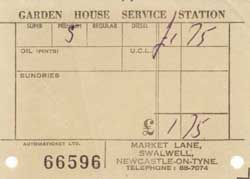 During the war Swalwell had barrage balloons as an anti aircraft measure,
During the war Swalwell had barrage balloons as an anti aircraft measure, 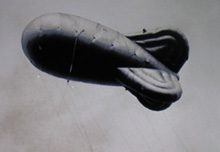 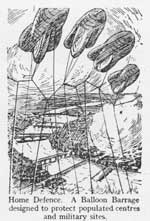 They were situated next to the cemetery on Market Lane and on the cricket ground. These were large balloons, see pictures, anchored to steel cables from winches, and which would cause serious damage to an enemy aircraft if it flew into them and further damage as the balloon itself was pulled down, to the aircraft fuselage and cockpit. They forced enemy aircraft to fly higher, making accurate bombing difficult. The barrage balloon site later became a filling station and garage (The Garden House Service Station, Mobil Oil) and is now occupied by houses. The Jet filling station in Hexham Road was built by Shield Bros. in 1964 and originally sold Fina petrol. Pictured is an old receipt for petrol from the 1970's for five gallons at 35p per gallon, or 7.71p per litre. Move mouse over bill to see the other side. They were situated next to the cemetery on Market Lane and on the cricket ground. These were large balloons, see pictures, anchored to steel cables from winches, and which would cause serious damage to an enemy aircraft if it flew into them and further damage as the balloon itself was pulled down, to the aircraft fuselage and cockpit. They forced enemy aircraft to fly higher, making accurate bombing difficult. The barrage balloon site later became a filling station and garage (The Garden House Service Station, Mobil Oil) and is now occupied by houses. The Jet filling station in Hexham Road was built by Shield Bros. in 1964 and originally sold Fina petrol. Pictured is an old receipt for petrol from the 1970's for five gallons at 35p per gallon, or 7.71p per litre. Move mouse over bill to see the other side.
Post Office, Doctor's Surgery, Fire Station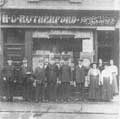 The Post Office was originally in Market Lane next to Lyndhust Terrace, see picture, but moved to the
The Post Office was originally in Market Lane next to Lyndhust Terrace, see picture, but moved to the former Angel Inn, next door to The Highlander. This Post Office was very dark inside and had a room on the left where mail was sorted. Mr Ryall was the postmaster. After closure the Post Office moved back to what was by then the Co-op hardware department in Market Lane before moving to its present situation in Crowley Road. It closed on 25 January 2005. former Angel Inn, next door to The Highlander. This Post Office was very dark inside and had a room on the left where mail was sorted. Mr Ryall was the postmaster. After closure the Post Office moved back to what was by then the Co-op hardware department in Market Lane before moving to its present situation in Crowley Road. It closed on 25 January 2005.
The doctor's surgery was at Leven House at the top of Millers Lane and the popular Doctor David (Smith), who I believe came from South Africa, was in attendance until shortly before the surgery closed in 1983 when Dr McNulty hailing from Leicester took over for a while before he and all his patients were transferred to Whickham Health Centre when the Swalwell surgery closed. No appointments were necessary in those days, you just turned up and waited your turn. There was another doctor's in Ridley Gardens in the 1950's, that of Doctor Kelly, whose practise Doctor Finarty later took over. Dental care in Swalwell was available in Napier Road from a dentist called Bowerbank in premises now occupied by Swalwell Taxis. Dental care in Swalwell was available in Napier Road from a dentist called Bowerbank in premises now occupied by Swalwell Taxis. Swalwell fire station, see picture, right, was opened in on 30 May 1963 by County Councillor Alice Jones, replacing the Fire Station on Dunston Road, Dunston dating from the Second World War. It was originally part of Durham County Fire Brigade, becoming part of Tyne and Wear Metropolitan Fire Brigade in 1974 and served Swalwell, Dunston, Whickham and the surrounding area. A new fire station has now been built at the top of Millers Lane.  Back to top of page Co-operative Society The Co-operative Society, see picture, was a large enterprise, occupying buildings on either side of Market Lane. On the south side it occupied the whole block from Napier Road to Spencer's Bank. Its history can be found on the Buildings page. The Co-op closed in the 1970's and some of the buildings are still in use on the south side of Market Lane, those on the other side of the street having been demolished together with Johnson's newsagents/tobacconists (which closed in November 1971) and the old barber's shop. Various foundation stones can be seen in the wall at the corner of Market Lane and Napier Road.An employee of the Co-op chemists in the nineteen sixties remembers phoning to Newcastle for a prescription which could not be filled at Swalwell, and it being sent by bus and collected at the specified stop of Swalwell schools. Buses would also carry parcels in those days.
(See also the Buildings page)
The Co-operative Society, see picture, was a large enterprise, occupying buildings on either side of Market Lane. On the south side it occupied the whole block from Napier Road to Spencer's Bank. Its history can be found on the Buildings page. The Co-op closed in the 1970's and some of the buildings are still in use on the south side of Market Lane, those on the other side of the street having been demolished together with Johnson's newsagents/tobacconists (which closed in November 1971) and the old barber's shop. Various foundation stones can be seen in the wall at the corner of Market Lane and Napier Road.An employee of the Co-op chemists in the nineteen sixties remembers phoning to Newcastle for a prescription which could not be filled at Swalwell, and it being sent by bus and collected at the specified stop of Swalwell schools. Buses would also carry parcels in those days.
(See also the Buildings page)
Bakeries , Fish and Chip ShopsThere were three bakeries after the war, the one at the foot of Axwell Terrace still exists, another was the old Ramsay's, formerly Cooly's in Crowley Road/Napier Road and the third was in a house on the left side of Napier Road near the junction with Crowley Road which was briefly a bakery in the early 1950's. There were two fish and chip shops one called the Top fish shop, or Tinnions, in Spencer's Bank, the other was the Bottom fish shop,or Annies, (Coxon's) next to The Sun. The latter used to sell St James' brand of pop made in Newcastle's west end and which beat any other make I ever had.Memories of Derwenthaugh from Keith Stead, former resident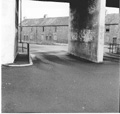 Derwenthaugh was split into two by the railway. On the River Tyne side where I lived were Malton Terrace and Railway cottages, the latter was demolished in 1950 by my uncle. The only family that I remember living there were the Halls, they moved to Winlaton. Living at Malton Terrace were my family,the Smiths (moved to Axwell Park in1948) and the Dodds family (Betty and Derek and daughter Glynis), and the Hindsons. They had 2 daughters, Judith and Dorothy (they moved to Swalwell about 1955). We all went to Swalwell school, walked every day.
Derwenthaugh was split into two by the railway. On the River Tyne side where I lived were Malton Terrace and Railway cottages, the latter was demolished in 1950 by my uncle. The only family that I remember living there were the Halls, they moved to Winlaton. Living at Malton Terrace were my family,the Smiths (moved to Axwell Park in1948) and the Dodds family (Betty and Derek and daughter Glynis), and the Hindsons. They had 2 daughters, Judith and Dorothy (they moved to Swalwell about 1955). We all went to Swalwell school, walked every day.On the other side of the railway was the Skiff Inn and up to about 1955 several houses and cottages. The only name I remember was Rolf. There were no shops, shopping was done at Blaydon or Scotswood. The Dodds and ourselves (Steads) were the last to leave in 1957. On the Skiff side was the waggon and engine repair sheds for Consett Iron and Steel, later NCB. It was quite a big site, we were not allowed to play there as it was too dangerous. The terrace of houses we lived in had no electricity, no hot water, and only an outside dry toilet but we had gas. We listened to the wireless which was powered by accumulators, charged up at the garage at Scotswood bridge at the cost of 2d a time. The tow path ran past the front of the terrrace and every day the workers at the Delta walked by going to work or going home, catching the tram at Scotswood to Newcastle. Back to top of page |
Miscellaneous
|
|
Street sales, etcMany firms operated vans which toured the streets selling foodstuffs, usually on the same day each week. Huthinson's the greengrocer was a Saturday visitor to our street, Mr Boyle the fishmonger came another day, and the Co-op milkman with his cart, every day. Walls ice cream van came one dinner time each week, while the Rington's Tea, Easton's with his coal and Glendale's of Gosforth mineral waters vehicles were regularly seen. Rag and bone men often came around the streets attracting attention with their unintelligible cries. Finally, on Saturdays during the football season there would be someone selling the Football Pink giving all the scores and match reports within an hour or so of the final whistle.Click here for shops, etc. slideshow |
THE TOWN GATE AND THE KEELMAN'S BRIDGE
This is the area in front of the Three Tuns or 3 T's where the big roundabout is now. The word gate used in this sense is said to originate in the Borderlands where the workmen would use high walls with one gate to protect their homes from the Scots or the moss troopers/border reivers, (the lawless English and Scots family-based gangs who roamed the borders in the sixteenth century raiding cattle and often burning and killing in the process). In the evenings they would meet at the gate and talk and this place of meeting was called the Towngate. Many of the borderers came south to seek work in coal mining or on the wagonways and thus the Towngate at Swalwell supposedly got its name. However, Bourne, in his history of Whickham Parish states that the word gate was the distance between a colliery and the staith to which the coals were brought for shipping and that the term gate is thus associated with the old wagonways, hence Crookgate, a curved way,Watergate, where the horses were watered and the Towngate, the start of the coalway to Dunston. |
| Previous........Next |